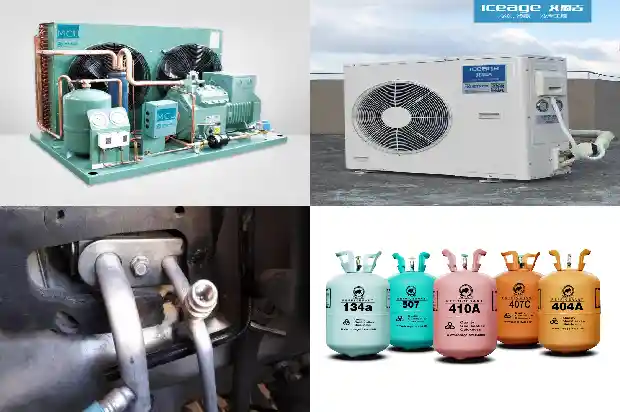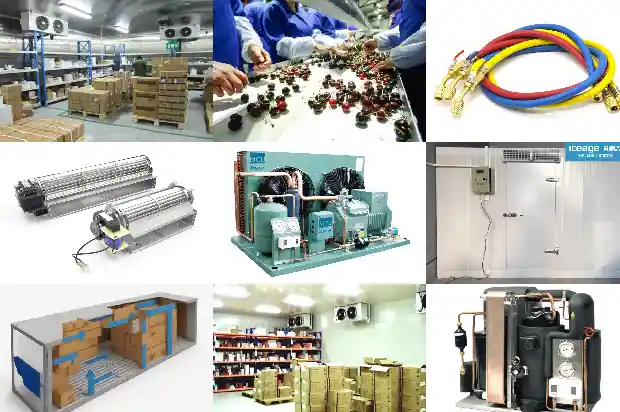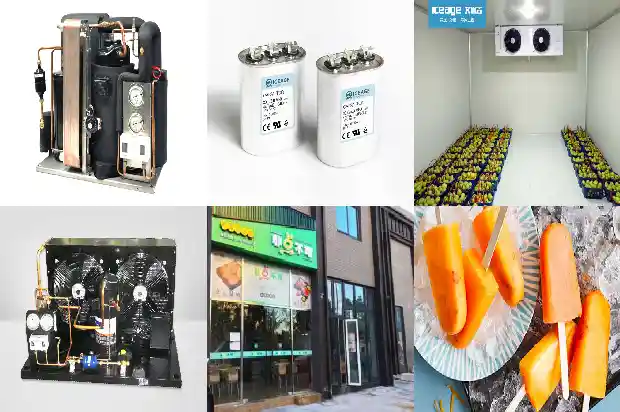Common Causes and Analysis of High and Low Pressure Alarms
2024-12-22
I. Common Causes and Analysis of High-Pressure Alarms:
The flow rate of cooling water (or air) is too low to carry away the condensation heat of the compressor.
The temperature of cooling water (or air) is relatively high, resulting in poor heat exchange and inability to carry away the condensation heat of the compressor.
There is air in the system, which causes the condensation pressure to rise.
The amount of refrigerant charged is excessive, and the liquid occupies the effective condensation area, thus increasing the condensation pressure.
The condenser has been out of repair for a long time, and the heat transfer surface is seriously fouled (or the air-cooled condenser is too dirty), which can also lead to an increase in the condensation pressure. The existence of scale also has a significant impact on the condensation pressure.
The flow rate of cooling water (or air) is too low to carry away the condensation heat of the compressor.


The temperature of cooling water (or air) is relatively high, resulting in poor heat exchange and inability to carry away the condensation heat of the compressor.
There is air in the system, which causes the condensation pressure to rise.
The amount of refrigerant charged is excessive, and the liquid occupies the effective condensation area, thus increasing the condensation pressure.
The condenser has been out of repair for a long time, and the heat transfer surface is seriously fouled (or the air-cooled condenser is too dirty), which can also lead to an increase in the condensation pressure. The existence of scale also has a significant impact on the condensation pressure.
II. Common Causes and Analysis of Low-Pressure Alarms:
The opening degree of the expansion valve is too small.
The refrigeration system is short of refrigerant.
The capillary tube or the expansion valve is blocked.
The filter is clogged.
The air volume of the indoor unit is insufficient.
The evaporator is seriously frosted.
The opening degree of the expansion valve is too small.
The refrigeration system is short of refrigerant.
The capillary tube or the expansion valve is blocked.

The filter is clogged.
The air volume of the indoor unit is insufficient.
The evaporator is seriously frosted.
III. Common Causes and Analysis of Oil Pressure Difference Alarms:
There is not enough refrigeration oil, resulting in an insufficient oil level in the compressor crankcase, and the oil pump cannot suck in oil.
The oil is dirty, causing the oil pump filter to be blocked.
The oil pressure difference relay fails.
The oil pump malfunctions.
There is a large amount of Freon in the refrigeration oil, making it impossible to build up oil pressure.
The liquid return is serious.
There is not enough refrigeration oil, resulting in an insufficient oil level in the compressor crankcase, and the oil pump cannot suck in oil.
The oil is dirty, causing the oil pump filter to be blocked.
The oil pressure difference relay fails.
The oil pump malfunctions.
There is a large amount of Freon in the refrigeration oil, making it impossible to build up oil pressure.
The liquid return is serious.
IV. Common Causes and Analysis of Compressor Thermal Protection:
The return gas volume of the system is insufficient, and the motor is not adequately cooled.
The power supply voltage is abnormal, there is a phase loss, or the motor is overloaded.
The condensation pressure is too high, etc.
These cause overheating phenomena such as high motor temperature, excessive exhaust temperature, and burnt lubricating oil.
The return gas volume of the system is insufficient, and the motor is not adequately cooled.
The power supply voltage is abnormal, there is a phase loss, or the motor is overloaded.
The condensation pressure is too high, etc.
These cause overheating phenomena such as high motor temperature, excessive exhaust temperature, and burnt lubricating oil.
V. Common Causes and Analysis of Poor Refrigeration Effect:
The expansion valve is opened too much or too little.
The refrigeration system is blocked and not smooth, or relevant valves are not opened or not fully opened, or the solenoid valve fails, etc.
There is not enough refrigerant.
There is a fault in the internal structure of the compressor.
The expansion valve is opened too much or too little.
The refrigeration system is blocked and not smooth, or relevant valves are not opened or not fully opened, or the solenoid valve fails, etc.
There is not enough refrigerant.
There is a fault in the internal structure of the compressor.
VI. Common Causes and Analysis of Exhaust Temperature Alarms:
The suction pressure is too low, the suction and exhaust pressure difference is too large, and the opening degree of the expansion valve is small.
The suction temperature is too high, that is, the suction superheat degree is large, and the suction pipe is too long or the heat preservation effect is poor.
The cooling water volume is insufficient or the water temperature is too high.
There is too much non-condensable gas (air) in the system.
The condensation pressure is too high, and the corresponding condensation temperature is also high, causing the exhaust temperature to rise.
The suction pressure is too low, the suction and exhaust pressure difference is too large, and the opening degree of the expansion valve is small.
The suction temperature is too high, that is, the suction superheat degree is large, and the suction pipe is too long or the heat preservation effect is poor.
The cooling water volume is insufficient or the water temperature is too high.
There is too much non-condensable gas (air) in the system.
The condensation pressure is too high, and the corresponding condensation temperature is also high, causing the exhaust temperature to rise.
VII. Common Causes and Analysis of Serious Frosting on the Evaporator:
The air volume of the evaporator fan is insufficient, resulting in poor heat exchange.
The evaporator is too dirty, affecting the heat exchange of the evaporator.
Too much refrigerant enters the evaporator, resulting in insufficient heat exchange.
The working condition temperature is too low and the humidity is too high.
The air volume of the evaporator fan is insufficient, resulting in poor heat exchange.
The evaporator is too dirty, affecting the heat exchange of the evaporator.
Too much refrigerant enters the evaporator, resulting in insufficient heat exchange.
The working condition temperature is too low and the humidity is too high.
VIII. Common Causes and Analysis of Poor Oil Return in the Refrigeration System:
The oil return filter is dirty and blocked, and the oil return pipeline is dirty and blocked, resulting in the inability of the oil to return.
The oil separator has been used for too long, and its efficiency has decreased.
The exhaust temperature is too high, and the efficiency of oil separation has decreased.
There is no oil return bend in the suction pipeline, resulting in oil being stored in the evaporator or other gas pipelines.
The opening degree of the expansion valve is too small, and the flow velocity of the refrigerant gas in the suction pipe is too low to bring the oil back to the compressor.
The oil return filter is dirty and blocked, and the oil return pipeline is dirty and blocked, resulting in the inability of the oil to return.
The oil separator has been used for too long, and its efficiency has decreased.
The exhaust temperature is too high, and the efficiency of oil separation has decreased.
There is no oil return bend in the suction pipeline, resulting in oil being stored in the evaporator or other gas pipelines.
The opening degree of the expansion valve is too small, and the flow velocity of the refrigerant gas in the suction pipe is too low to bring the oil back to the compressor.
IX. Common Causes and Analysis of Exhaustively High Suction Temperature of the Compressor:
There is a shortage of refrigerant, and the refrigerant has already been overheated in the evaporator.
The expansion valve is blocked or the pipeline is blocked, resulting in a shortage of refrigerant in the evaporator.
The opening degree of the expansion valve is too small or the throttling mechanism fails.
The suction pipeline is too long or the heat preservation of the suction pipe is poor.
There is a shortage of refrigerant, and the refrigerant has already been overheated in the evaporator.
The expansion valve is blocked or the pipeline is blocked, resulting in a shortage of refrigerant in the evaporator.
The opening degree of the expansion valve is too small or the throttling mechanism fails.
The suction pipeline is too long or the heat preservation of the suction pipe is poor.
X. How to Judge the Amount of Refrigerant Charged
Weighing Method: The most accurate and scientific way is the weighing method. Just charge the refrigerant according to the indicated charging amount on the nameplate of the refrigeration equipment by weighing.
Besides the "weighing method", there are also commonly used methods for judging the charging amount, such as:
Liquid Sight Glass Method,
Current Method,
Pressure Gauge Method,
Suction Superheat Degree Method.
Weighing Method: The most accurate and scientific way is the weighing method. Just charge the refrigerant according to the indicated charging amount on the nameplate of the refrigeration equipment by weighing.
Besides the "weighing method", there are also commonly used methods for judging the charging amount, such as:
Liquid Sight Glass Method,
Current Method,
Pressure Gauge Method,
Suction Superheat Degree Method.
Related Articles
- What Are the Common Causes of Cold Air Blower Noise?
- Air - conditioner Low - pressure Alarm? These Nine Common Causes
- What Are the Causes of Scroll Compressor Damage?
- Causes and Prevention of "Primary Condensation" and "Secondary Condensation" in Fan - Coil Units
- 10 Symptoms and Causes of Abnormal Frosting in Heat Pumps
- Common Causes and Analysis of Compressor Thermal Protection
- 4 Points on Causes of Water Leakage in Closed Cooling Towers
- Analysis of Causes for Safety Valve Leakage
- What Causes Noise in Pressure Reducing Valves?
- Causes and Solutions for Elevated Pressure in Cold Storage
- Common Causes of Frost Build-up in refrigerant evaporators
- What Causes Poor Refrigeration Effect of Refrigerated Trucks?
- Common Causes of Air Conditioner Compressor Failures
- Analysis of Seven Reasons for Ice Formation in Computer Room Air Conditioners
- Analysis and Troubleshooting of Common Faults in Air - source Heat Pumps
- Analysis of 6 Components in Air - cooled Multi - split Systems
- Analysis of Advantages, Disadvantages and 34 Common Components of Multi - split Air Conditioners
- Analysis of Common Faults in Compressor Overcurrent and Burnout
